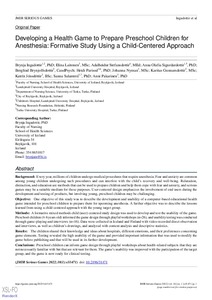Developing a Health Game to Prepare Preschool Children for Anesthesia: Formative Study Using a Child-Centered Approach
Ingadottir Brynja; Laitonen Elina; Stefansdottir Adalheidur; Sigurdardottir Anna Olafia; Brynjolfsdottir Berglind; Parisod Heidi; Nyman Johanna; Gunnarsdottir Karitas; Jónsdóttir Katrín; Salanterä Sanna; Pakarinen Anni
https://urn.fi/URN:NBN:fi-fe2022081154450
Tiivistelmä
Background: Every year, millions of children undergo medical procedures that require anesthesia. Fear and anxiety are common among young children undergoing such procedures and can interfere with the child's recovery and well-being. Relaxation, distraction, and education are methods that can be used to prepare children and help them cope with fear and anxiety, and serious games may be a suitable medium for these purposes. User-centered design emphasizes the involvement of end users during the development and testing of products, but involving young, preschool children may be challenging.
Objective: One objective of this study was to describe the development and usability of a computer-based educational health game intended for preschool children to prepare them for upcoming anesthesia. A further objective was to describe the lessons learned from using a child-centered approach with the young target group.
Methods: A formative mixed methods child (user)-centered study design was used to develop and test the usability of the game. Preschool children (4-6 years old) informed the game design through playful workshops (n=26), and usability testing was conducted through game-playing and interviews (n=16). Data were collected in Iceland and Finland with video-recorded direct observation and interviews, as well as children's drawings, and analyzed with content analysis and descriptive statistics.
Results: The children shared their knowledge and ideas about hospitals, different emotions, and their preferences concerning game elements. Testing revealed the high usability of the game and provided important information that was used to modify the game before publishing and that will be used in its further development.
Conclusions: Preschool children can inform game design through playful workshops about health-related subjects that they are not necessarily familiar with but that are relevant for them. The game's usability was improved with the participation of the target group, and the game is now ready for clinical testing.
Kokoelmat
- Rinnakkaistallenteet [27094]
